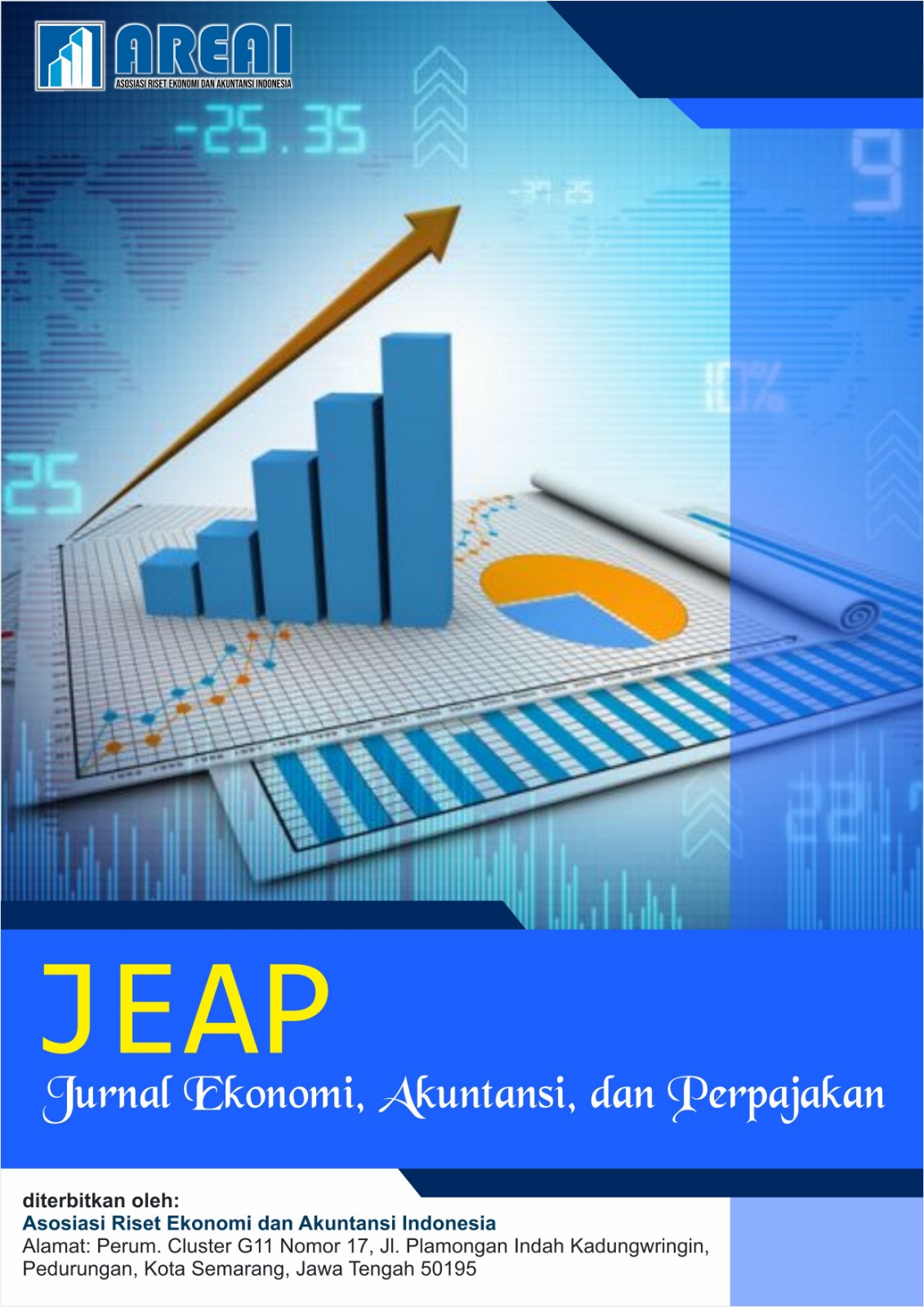Pengaruh Earnings Performance Terhadap Cumulative Abnormal Return dengan Internal Control sebagai Variabel Moderasi
DOI:
https://doi.org/10.61132/jeap.v2i2.925Keywords:
Control, Earnings, ReturnAbstract
Earnings performance is seen as one of the main indicators in assessing the company's financial performance, which can influence investor decisions and be reflected in market reactions through abnormal returns. Meanwhile, internal control is considered as an internal control mechanism that can strengthen investor confidence in the quality of earnings information submitted by the company. This study aims to examine the effect of earnings performance on cumulative abnormal return (CAR) and the role of internal control as a moderating variable in the relationship. The focus of this research is on real estate and property sector companies listed on the Indonesia Stock Exchange (IDX) during the 2019-2023 period. The sample of this study consisted of 44 companies and 199 observations selected through purposive sampling technique with certain criteria. Hypothesis testing was carried out using moderated regression analysis. The results showed that earnings performance has a positive and significant effect on cumulative abnormal return, which indicates that the better the company's earnings performance, the higher the positive market reaction to the information. In addition, other findings show that internal control moderates positively and significantly the relationship between earnings performance and cumulative abnormal return. This means that the effect of earnings performance on CAR will be stronger in companies that have a good internal control system.
Downloads
References
Awawdeh, H. A., Al-Sakini, S. A., & Nour, M. (2020). Factors affecting earnings response coefficient in Jordan: Applied study on the Jordanian industrial companies. Investment Management and Financial Innovations, 17(2), 255–265. https://doi.org/10.21511/imfi.17(2).2020.20
Ball, R., & Brown, P. (1968). An empirical evaluation of accounting income numbers. Journal of Accounting Research, 6(2), 159–178. https://doi.org/10.2307/2490232
Bessembinder, H., Kahle, K. M., Maxwell, W. F., & Xu, D. (2017). Capital markets in the twenty-first century: The role of equity markets. Annual Review of Financial Economics, 9, 1–21.
Brigham, F. E., & Houston, F. J. (2019). Dasar-dasar manajemen keuangan. Jakarta: Salemba Empat.
Chen, L., Krishnan, G. V., Pevzner, M., & Sami, H. (2019). Accounting conservatism and stock price crash risk: Firm-level evidence. Review of Accounting Studies, 24(1), 226–271.
Committee of Sponsoring Organizations of the Treadway Commission (COSO). (2017). Enterprise risk management: Integrating with strategy and performance. COSO.
Dang, T. H., & Nguyen, H. T. (2021). The relationship between earnings performance and stock market response. Financial Research Letters, 43, 101540. https://doi.org/10.1016/j.frl.2021.101540
Fama, E. F. (1970). Efficient capital markets. The Journal of Finance, 25(2), 383–417. https://doi.org/10.2307/2325486
Gupta, P. P., Sami, H., & Zhou, H. (2016). Do companies with effective internal control over financial reporting benefit from Sarbanes-Oxley Section 302 and 404? Journal of Accounting, Auditing, and Finance.
Herdiri, A., & Sherla, S. (2015). Earnings performance and its impact on cumulative abnormal return. Journal of Finance and Accounting, 3(1), 45–58.
Hunt, T. W., Lee, J., & Chen, X. (2022). Evaluating financial health through earnings performance. Journal of Business and Finance, 18(3), 204–218. https://doi.org/10.1016/j.jbf.2022.01.012
Hutabarat, R. (2021). Analisis kinerja laba perusahaan: Konsep dan aplikasi dalam keuangan. Jakarta: Penerbit Ekonomi Nusantara.
International Accounting Standards Board. (2018). Conceptual framework for financial reporting. IFRS Foundation.
Jessica, J., & Triyani, Y. (2022). Pengaruh struktur modal, likuiditas, ukuran perusahaan dan umur perusahaan terhadap kinerja keuangan. Jurnal Akuntansi, 11(2), 138–148.
Kieso, D. E., Weygandt, J. J., & Warfield, T. D. (2020). Intermediate accounting (17th ed.). Hoboken, NJ: Wiley.
Kristanti, F. T. (2018). Pengaruh kinerja keuangan terhadap return saham dengan kebijakan dividen sebagai variabel moderasi [Skripsi tidak diterbitkan]. Universitas.
Li, F., & Zhao, R. (2020). The effect of earnings quality on stock price synchronicity: Evidence from firm-level data. Journal of Accounting Research, 58(3), 651–687.
Liu, Z., Saidin, S. F., & Osman, M. N. (2024). The effect of internal control on earnings response coefficient. Asian Journal of Accounting Research.
Nurjanah, S. (2022). Pengaruh informasi laba dan ukuran perusahaan terhadap harga saham pada perusahaan IDX BUMN20 yang terdaftar di Bursa Efek Indonesia. Jurnal Kajian Ilmiah Akuntansi.
Siswanto, E. (2021). Manajemen keuangan dasar. Malang: Universitas Negeri Malang.
Spence, M. (1973). Job market signaling. Quarterly Journal of Economics.
Suharti, E., & Saftiana, L. I. (2021). Reaksi pasar dan implikasinya terhadap harga saham. Jurnal Monex.
Sun, P.-W., & Wen, Z. (2022). Stock return predictability of the cumulative abnormal returns around the earnings announcement date: Evidence from China. International Review of Finance.
Downloads
Published
How to Cite
Issue
Section
License
Copyright (c) 2025 Jurnal Ekonomi, Akuntansi, dan Perpajakan

This work is licensed under a Creative Commons Attribution-ShareAlike 4.0 International License.





